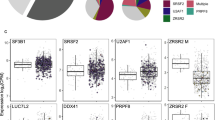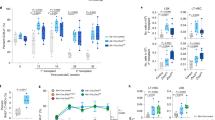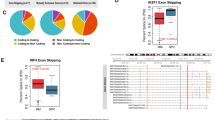Abstract
Recurrent mutations in core splicing factors have been reported in several clonal disorders, including cancers. Mutations in SF3B1, a component of the U2 splicing complex, are the most common. SF3B1 mutations are associated with aberrant pre-mRNA splicing using cryptic 3′ splice sites (3′SSs), but the mechanism of their selection is not clear. To understand how cryptic 3′SSs are selected, we performed comprehensive analysis of transcriptome-wide changes to splicing and gene expression associated with SF3B1 mutations in patient samples as well as an experimental model of inducible expression. Hundreds of cryptic 3′SS were detectable across the genome in cells expressing mutant SF3B1. These 3′SS are typically sequestered within RNA secondary structures and poorly accessible compared with their corresponding canonical 3′SS. We hypothesized that these cryptic 3′SS are inaccessible during normal splicing catalysis and that this constraint is overcome in spliceosomes containing mutant SF3B1. This model of secondary structure-dependent selection of cryptic 3′SS was found across multiple clonal processes associated with SF3B1 mutations (myelodysplastic syndrome and chronic lymphocytic leukemia). We validated our model predictions in mini-gene splicing assays. Additionally, we found deregulated expression of proteins with relevant functions in splicing factor-related diseases both in association with aberrant splicing and without corresponding splicing changes. Our results show that SF3B1 mutations are associated with a distinct splicing program shared across multiple clonal processes and define a biochemical mechanism for altered 3′SS choice.
This is a preview of subscription content, access via your institution
Access options
Subscribe to this journal
Receive 50 print issues and online access
$259.00 per year
only $5.18 per issue
Buy this article
- Purchase on Springer Link
- Instant access to full article PDF
Prices may be subject to local taxes which are calculated during checkout






Similar content being viewed by others
References
Yoshida K, Ogawa S . Splicing factor mutations and cancer. Wiley Interdiscip Rev RNA 2014; 5: 445–459.
Greenberg PL, Young NS, Gattermann N . Myelodysplastic syndromes. Hematology Am Soc Hematol Educ Program 2002; 1: 136–161.
Bejar R, Steensma DP . Recent developments in myelodysplastic syndromes. Blood 2014; 124: 2793–2803.
Papaemmanuil E, Cazzola M, Boultwood J, Malcovati L, Vyas P, Bowen D et al. Somatic SF3B1 mutation in myelodysplasia with ring sideroblasts. N Engl J Med 2011; 365: 1384–1395.
Yoshida K, Sanada M, Shiraishi Y, Nowak D, Nagata Y, Yamamoto R et al. Frequent pathway mutations of splicing machinery in myelodysplasia. Nature 2011; 478: 64–69.
Graubert TA, Shen D, Ding L, Okeyo-Owuor T, Lunn CL, Shao J et al. Recurrent mutations in the U2AF1 splicing factor in myelodysplastic syndromes. Nat Genet 2012; 44: 53–57.
Wang L, Lawrence MS, Wan Y, Stojanov P, Sougnez C, Stevenson K et al. SF3B1 and other novel cancer genes in chronic lymphocytic leukemia. N Engl J Med 2011; 365: 2497–2506.
Harbour JW, Roberson EDO, Anbunathan H, Onken MD, Worley LA, Bowcock AM . Recurrent mutations at codon 625 of the splicing factor SF3B1 in uveal melanoma. Nat Genet 2013; 45: 133–135.
Gozani O, Feld R, Reed R . Evidence that sequence-independent binding of highly conserved U2 snRNP proteins upstream of the branch site is required for assembly of spliceosomal complex A. Genes Dev 1996; 10: 233–243.
DeBoever C, Ghia EM, Shepard PJ, Rassenti L, Barrett CL, Jepsen K et al. Transcriptome sequencing reveals potential mechanism of cryptic 3′ splice site selection in SF3B1-mutated cancers. PLoS Comput Biol 2015; 11: e1004105.
Darman RB, Seiler M, Agrawal AA, Lim KH, Peng S, Aird D et al. Cancer-associated SF3B1 hotspot mutations induce cryptic 3? Splice site selection through use of a different branch point. Cell Rep 2015; 13: 1033–1045.
Wang C, Chua K, Seghezzi W, Lees E, Gozani O, Reed R . Phosphorylation of spliceosomal protein SAP 155 coupled with splicing catalysis. Genes Dev 1998; 12: 1409–1414.
Dolatshad H, Pellagatti A, Fernandez-Mercado M, Yip BH, Malcovati L, Attwood M et al. Disruption of SF3B1 results in deregulated expression and splicing of key genes and pathways in myelodysplastic syndrome hematopoietic stem and progenitor cells. Leukemia 2014; 29: 1092–1103.
Alsafadi S, Houy A, Battistella A, Popova T, Wassef M, Henry E et al. Cancer-associated SF3B1 mutations affect alternative splicing by promoting alternative branchpoint usage. Nat Commun 2016; 7: 10615.
Buratti E, Baralle FE . Influence of RNA secondary structure on the pre-mRNA splicing process. Mol Cell Biol 2004; 24: 10505–10514.
Meyer M, Plass M, Pérez-Valle J, Eyras E, Vilardell J . Deciphering 3′SS selection in the yeast genome reveals an RNA thermosensor that mediates alternative splicing. Mol Cell 2011; 43: 1033–1039.
Vořechovský I . Aberrant 3′ splice sites in human disease genes: mutation pattern, nucleotide structure and comparison of computational tools that predict their utilization. Nucleic Acids Res 2006; 34: 4630–4641.
Warf MB, Berglund JA . Role of RNA structure in regulating pre-mRNA splicing. Trends Biochem Sci 2010; 35: 169–178.
Chua K, Reed R . An upstream AG determines whether a downstream AG is selected during catalytic step II of splicing. Mol Cell Biol 2001; 21: 1509–1514.
Smith CW, Chu TT, Nadal-Ginard B . Scanning and competition between AGs are involved in 3′ splice site selection in mammalian introns. Mol Cell Biol 1993; 13: 4939–4952.
Zuker M . Mfold web server for nucleic acid folding and hybridization prediction. Nucleic Acids Res 2003; 31: 3406–3415.
Mahen EM, Watson PY, Cottrell JW, Fedor MJ . mRNA secondary structures fold sequentially but exchange rapidly in vivo. PLoS Biol 2010; 8: e1000307.
Bevilacqua PC, Blose JM . Structures, kinetics, thermodynamics, and biological functions of RNA hairpins. Annu Rev Phys Chem 2008; 59: 79–103.
Plass M, Codony-Servat C, Ferreira PG, Vilardell J, Eyras E . RNA secondary structure mediates alternative 3′SS selection in Saccharomyces cerevisiae. RNA 2012; 18: 1103–1115.
Plass M, Eyras E . Approaches to link RNA secondary structures with splicing regulation. Methods Mol Biol 2014; 1126: 341–356.
Mercer TR, Clark MB, Andersen SB, Brunck ME, Haerty W, Crawford J et al. Genome-wide discovery of human splicing branchpoints. Genome Res 2015; 25: 290–303.
Corvelo A, Hallegger M, Smith CWJ, Eyras E . Genome-wide association between branch point properties and alternative splicing. PLoS Comput Biol 2010; 6: e1001016.
Gruber AR, Lorenz R, Bernhart SH, Neuböck R, Hofacker IL . The Vienna RNA Websuite. Nucleic Acids Res 2008; 36: W70–W74.
Pollard KS, Hubisz MJ, Rosenbloom KR, Siepel A . Detection of nonneutral substitution rates on mammalian phylogenies. Genome Res 2010; 20: 110–121.
Lai Y, Yue Y, Liu M, Duan D . Synthetic intron improves transduction efficiency of trans-splicing adeno-associated viral vectors. Hum Gene Ther 2006; 17: 1036–1042.
Orengo JP, Bundman D, Cooper TA . A bichromatic fluorescent reporter for cell-based screens of alternative splicing. Nucleic Acids Res 2006; 34: e148.
Trapnell C, Roberts A, Goff L, Pertea G, Kim D, Kelley DR et al. Differential gene and transcript expression analysis of RNA-seq experiments with TopHat and Cufflinks. Nat Protoc 2012; 7: 562–578.
Gerstein MB, Rozowsky J, Yan K-K, Wang D, Cheng C, Brown JB et al. Comparative analysis of the transcriptome across distant species. Nature 2014; 512: 445–448.
Ilagan JO, Ramakrishnan A, Hayes B, Murphy ME, Zebari AS, Bradley P et al. U2AF1 mutations alter splice site recognition in hematological malignancies. Genome Res 2015; 25: 14–26.
Kontos CK, Scorilas A . Molecular cloning of novel alternatively spliced variants of BCL2L12, a new member of the BCL2 gene family, and their expression analysis in cancer cells. Gene 2012; 505: 153–166.
Merritt WM, Lin YG, Han LY, Kamat AA, Spannuth WA, Schmandt R et al. Dicer, Drosha, and outcomes in patients with ovarian cancer. N Engl J Med 2008; 359: 2641–2650.
Cameron JM, Janer A, Levandovskiy V, Mackay N, Rouault TA, Tong W-H et al. Mutations in iron-sulfur cluster scaffold genes NFU1 and BOLA3 cause a fatal deficiency of multiple respiratory chain and 2-oxoacid dehydrogenase enzymes. Am J Hum Genet 2011; 89: 486–495.
Okeyo-Owuor T, White BS, Chatrikhi R, Mohan DR, Kim S, Griffith M et al. U2AF1 mutations alter sequence specificity of pre-mRNA binding and splicing. Leukemia 2015; 29: 909–917.
Kaganovich D, Kopito R, Frydman J . Misfolded proteins partition between two distinct quality control compartments. Nature 2008; 454: 1088–1095.
Floor SN, Doudna JA . Tunable protein synthesis by transcript isoforms in human cells. eLife 2016; 5: 1–25.
Shaw GC, Cope JJ, Li L, Corson K, Hersey C, Ackermann GE et al. Mitoferrin is essential for erythroid iron assimilation. Nature 2006; 440: 96–100.
Visconte V, Rogers HJ, Singh J, Barnard J, Bupathi M, Traina F et al. SF3B1 haploinsufficiency leads to formation of ring sideroblasts in myelodysplastic syndromes. Blood 2012; 120: 3173–3186.
Paradkar PN, Zumbrennen KB, Paw BH, Ward DM, Kaplan J . Regulation of mitochondrial iron import through differential turnover of mitoferrin 1 and mitoferrin 2. Mol Cell Biol 2009; 29: 1007–1016.
Min IM, Pietramaggiori G, Kim FS, Passegué E, Stevenson KE, Wagers AJ . The transcription factor EGR1 controls both the proliferation and localization of hematopoietic stem cells. Cell Stem Cell 2008; 2: 380–391.
Moon YS, Smas CM, Lee K, Villena JA, Kim K-H, Yun EJ et al. Mice lacking paternally expressed Pref-1/Dlk1 display growth retardation and accelerated adiposity. Mol Cell Biol 2002; 22: 5585–5592.
Sakajiri S, O’kelly J, Yin D, Miller CW, Hofmann WK, Oshimi K et al. Dlk1 in normal and abnormal hematopoiesis. Leukemia 2005; 19: 1404–1410.
Popp MW-L, Maquat LE . The dharma of nonsense-mediated mRNA decay in Mammalian cells. Mol Cells 2014; 37: 1–8.
Ishigaki Y, Li X, Serin G, Maquat LE . Evidence for a pioneer round of mRNA translation: mRNAs subject to nonsense-mediated decay in mammalian cells are bound by CBP80 and CBP20. Cell 2001; 106: 607–617.
Horowitz DS . The mechanism of the second step of pre-mRNA splicing. Wiley Interdiscip Rev RNA 2012; 3: 331–350.
Obeng EA, McConkey ME, Campagna D, Schneider RK, Chen MC, Schmidt PJ et al. Mutant splicing factor 3b subunit 1 (SF3B1) causes dysregulated erythropoiesis and a stem cell disadvantage. Blood 2014; 124: 828–828.
Mupo A, Sathiaseelan V, Seiler M, Kent D, Peng S, Bautista R et al. Sf3b1 K700E mutation impairs pre-mRNA splicing and definitive hematopoiesis in a conditional knock-in mouse model. Blood 2015; 126: 140–140.
Cordin O, Beggs JD . RNA helicases in splicing. RNA Biol 2013; 10: 83–95.
Polprasert C, Schulze I, Sekeres MA, Makishima H, Przychodzen B, Hosono N et al. Inherited and somatic defects in DDX41 in myeloid neoplasms. Cancer Cell 2015; 27: 658–670.
Kfir N, Lev-Maor G, Glaich O, Alajem A, Datta A, Sze SK et al. SF3B1 association with chromatin determines splicing outcomes. Cell Rep 2015; 11: 618–629.
Kim E, Ilagan JO, Liang Y, Daubner GM, Lee SC-W, Ramakrishnan A et al. SRSF2 mutations contribute to myelodysplasia by mutant-specific effects on exon recognition. Cancer Cell 2015; 27: 617–630.
Meerbrey KL, Hu G, Kessler JD, Roarty K, Li MZ, Fang JE et al. The pINDUCER lentiviral toolkit for inducible RNA interference in vitro and in vivo. PNAS 2011; 108: 3665–3670.
Balakrishnan I, Yang X, Brown J, Ramakrishnan A, Torok-Storb B, Kabos P et al. Genome-wide analysis of miRNA-mRNA interactions in marrow stromal cells. Stem Cells 2013; 32: 662–673.
Adiconis X, Borges-Rivera D, Satija R, DeLuca DS, Busby MA, Berlin AM et al. Comparative analysis of RNA sequencing methods for degraded or low-input samples. Nat Methods 2013; 10: 623–629.
Acknowledgements
Work was funded in part by the National Institutes of Health (R01 HL104070 to MMP and R01 HL098608 to ACM). We thank Barry Paw (Boston Children's Hospital, Boston, MA, USA) for anti-Mitoferrin antibody, Thomas A Cooper (Baylor College of Medicine, Houston, TX, USA) for the RG6 plasmid and Karla Neugebauer (Yale University) for helpful suggestions. We also thank The Yale Center for Genome Analysis (YCGA) for high-throughput sequencing and the Yale University Biomedical High Performance Computing Center for use of compute clusters to run bioinformatics analysis.
Author contributions
AK analyzed next-generation data and wrote the manuscript; OR performed experiments and wrote the manuscript; XY, AG and TM performed experiments; ACM designed some experiments, analyzed the data and edited the manuscript; MMP initiated the study, performed experiments, analyzed the data, provided supervision and wrote the manuscript with input from other authors.
Author information
Authors and Affiliations
Corresponding author
Ethics declarations
Competing interests
The authors declare no conflict of interest.
Additional information
Supplementary Information accompanies this paper on the Oncogene website
Rights and permissions
About this article
Cite this article
Kesarwani, A., Ramirez, O., Gupta, A. et al. Cancer-associated SF3B1 mutants recognize otherwise inaccessible cryptic 3′ splice sites within RNA secondary structures. Oncogene 36, 1123–1133 (2017). https://doi.org/10.1038/onc.2016.279
Received:
Revised:
Accepted:
Published:
Issue Date:
DOI: https://doi.org/10.1038/onc.2016.279
This article is cited by
-
SF3B1 hotspot mutations confer sensitivity to PARP inhibition by eliciting a defective replication stress response
Nature Genetics (2023)
-
Exploring the mechanistic link between SF3B1 mutation and ring sideroblast formation in myelodysplastic syndrome
Scientific Reports (2022)
-
Complex landscape of alternative splicing in myeloid neoplasms
Leukemia (2021)
-
Generation of scalable cancer models by combining AAV-intron-trap, CRISPR/Cas9, and inducible Cre-recombinase
Communications Biology (2021)
-
Full-length transcript characterization of SF3B1 mutation in chronic lymphocytic leukemia reveals downregulation of retained introns
Nature Communications (2020)



